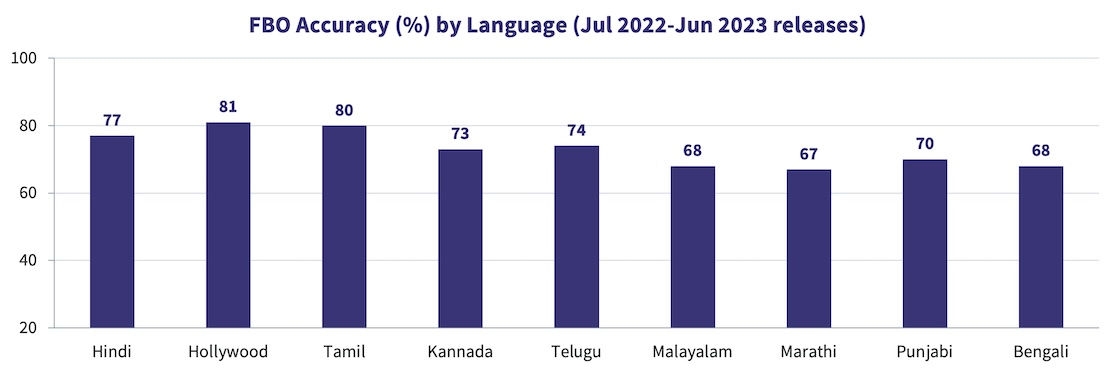


By Our Insights Desk
Launched in 2010, Ormax Cinematix is our campaign tracking and forecasting product for theatrical film releases. In 2012, we started forecasting the first-day box office (a parameter called FBO) in Ormax Cinematix, which has since then been a subject of much discussion in the Indian film industry. The product now runs across nine major languages, with more than 750 films being tracked every year.
Both current and potential subscribers of Ormax Cinematix have several questions related to FBO in particular. This post covers 12 such frequently-asked questions. We understand that you may have other queries too. We will be happy to connect with you and answer them.
1. How do you forecast the box office opening of films?
Ormax Cinematix (OCX) uses primary consumer research, conducted everyday through the year using online and telephonic research, to collect audience data on all films (across nine languages) that have an active pre-release campaign running at any point of time. This data is reported as three parameters: Buzz, Reach & Appeal. OCX’s FBO (First-Day Box Office) Model is a statistical tool that combines audience data (Buzz, Reach & Appeal) with distribution inputs (release scale, multiplex showcasing, Average Ticket Price, etc.) and extrinsic variables such as holidays, festive periods, cricket, IPL, etc., to forecast the first-day box office of all films at a daily level, leading up to the final FBO on the day of a film’s release.
2. How many subscribers does OCX currently have?
OCX subscriptions are available in various user-friendly packages. We encourage annual subscriptions, for continuity of data and understanding. However, some producers also avail subscriptions only for individual film campaigns. Subscription is available for single languages, as well as for language combinations. In the last 12 months, 31 producers/studios/companies have subscribed to OCX in one of these forms.
3. What measure do you use for box office?
Based on industry feedback, we use Gross box office as the measure for the four South languages (Tamil, Telugu, Kannada & Malayalam), and Nett box office for the other five languages (Hindi, Hollywood, Marathi, Punjabi & Bengali).
4. When does a film start getting reported in OCX? Are all films reported?
All major releases across nine languages are reported in OCX, including their FBO, once they are in “active campaign” stage, or from eight weeks before release (i.e., Wk -7 onwards, with Wk 0 being the week of release), whichever is later. The definition of active campaign varies by language, and we will be happy to share it offline. Whether a film is reported in OCX or not is not dependent on whether the producer/studio releasing the film is an OCX subscriber or not. Subscribing to OCX will not influence inclusion (or exclusion) of your film from OCX, or its FBO, in any way.
5. How do you define accuracy? What is your current accuracy level?
Accuracy of FBO is defined as 100 minus the sum of absolute deviations in FBO vs. actual first-day box office across all films, as a percentage of the cumulative first-day box office of these films. For example, if film X’s FBO was 10 Cr and its actual first-day box office was 11 Cr, its accuracy will be 100-(11-10)/11% = 91%. The chart below showcases the operating FBO accuracy across the nine OCX languages over the last 12 months.

6. Your forecast for a recent big release was significantly different from its actual opening. How is the accuracy so high then?
As explained above, accuracy is defined as the cumulative across all films released in that language. As is the case with any statistical forecasting model, not all forecasts will match the actual performance. It is only natural that deviations are remembered, and spoken of, more than the films that are forecast accurately, sometimes to the first-decimal place. At times, there are on-the-day factors that can play a significant role, especially extreme positive or extreme negative audience word-of-mouth that builds during the day through social media. The FBO Model is a self-learning model, and is updated every week. Every forecast that’s not close to actual performance helps the model calibrate itself, leading to improved accuracy over time.
7. What are your sources for actual box office figures, which you use to compare to FBO?
Given the limited, and often unreliable, availability of box office data in India, especially in specific languages, we use a mix of primary sources (production houses, exhibitors, distributors, etc.) and secondary sources (reliable online, trade sources for each language industry) to estimate the box office of various films. Box office of most films, especially the major ones, are validated by at least two sources. Actual numbers may vary by upto 5% for the bigger films and upto 10-15% for smaller films.
8. The pandemic has impacted the theatrical business significantly, and things are not yet settled. How does the FBO Model handle this?
The FBO Model has been in place since 2012 for the Hindi language, and from 2015/2017 for other major languages. When theatres re-opened in 2021 after a prolonged pandemic-induced closure, we discarded all pre-pandemic data, and built the FBO Model from scratch all over again. Hence, the current model is reflective of only the post-pandemic performance of films. The uncertainty of the box office poses additional challenges on the FBO Model, which it is learning to adapt to. This, in turn, should lead to improved accuracy, compared to the numbers above.
9. Between Buzz, Reach & Appeal, what is more important for a higher box office opening?
FBO is based on an interplay of the three parameters. Since the FBO Model is proprietary to us, we are unable to share specifics related to their individual impact, except to say that the answer to the question varies by languages, and also by the scale of the film.
10. I have observed that FBO goes up or down for some films closer to their release date. Do you consider advance bookings as an input to calculate FBO in the week of a film’s release?
No, advance bookings is not a parameter in the FBO Model. The model is based on audience inputs (Buzz, Reach & Appeal), which, in turn, will influence the advance booking as well. In almost all cases, significant changes in FBO closer to the release date are a result of a film’s distribution inputs (release scale, multiple showcasing & Average Ticket Price) being significantly different from what was originally estimated at the start of the campaign. We make our best efforts to estimate these inputs before a film enters the OCX report, including asking subscribers for estimated values for their films. However, factors such as performance of holdover releases, release date changes, trade sentiment, etc. can impact actual distribution vis-à-vis estimated, leading to FBO fluctuations, especially over the last 2-3 days.
11. How does the FBO Model factor for the clash of two major films releasing on the same day?
The FBO Model treats each film in a clash independent of each other. However, any major clash will impact the release scale of both films, which is an input into the FBO Model. A clash will also impact the Appeal of the films, as audience may choose to watch one of the films over the other, when faced with a choice on the first day. Hence, the FBO Model accounts for clashes implicitly, through its distribution and audience inputs.
12. I want to understand why the Buzz, Reach & Appeal, and hence the FBO, for my film is not increasing, despite my marketing being very visible. Is my media plan not effective? Or are my creatives not delivering? How can you help me with this?
At the end of every week, we report Buzz, Reach & Appeal by various target groups, such as gender, age, markets and theatre types, to help subscribers understand the strong and weak target groups for their film. Qualitative explanations of campaign performance are not covered in the scope of OCX. However, we do take up consulting projects of this nature, independent of OCX, where we provide data-led inputs on various aspects of a film’s marketing, such as positioning, creative strategy and media strategy. We also highly recommend pre-testing campaigns using our communication testing tool, which helps a producer/studio understand the first-day potential of their campaign, and gauge performance of each marketing asset (teasers, trailers, posters, songs, etc.) before they are in the public domain.

Product update: Content testing for the horror genre
Based on our accumulated audience insights, we are introducing genre-specific drivers for horror films and series in our content testing tools, Ormax Moviescope and Ormax Stream Test

The India Box Office Report: October 2025
Driven by Kantara - A Legend: Chapter-1, October 2025 has emerged as the highest-grossing box office month of the year at the India box office, with gross collections of ₹1,669 Cr

Venn It Happens: SVOD & Theatrical audience intersection
The second edition of our new feature Venn It Happens illustrates the intersection between SVOD and Theatrical audiences in India, using data from Ormax Media's industry reports
Subscribe to stay updated with our latest insights
We use cookies to improve your experience on this site. To find out more, read our Privacy Policy